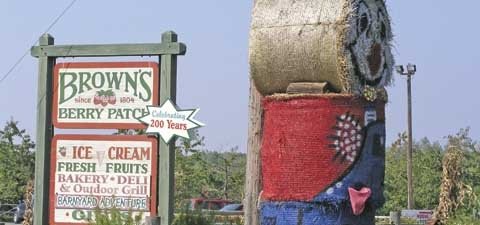 The Brown family of Waterport, New York, has grown apples and other crops for more than 200 years on the same farm, located along Oak Orchard River that leads to Lake Ontario. The farm was established in 1895 when Harry and Pearl Brown began specializing in tree fruit production, selling their flock of sheep to buy quince trees. Later, they had what was reputed to be the world’s largest quince orchard, with more than 60 acres. By 1900, they were shipping apples to New York City and Europe in wooden barrels. Tree fruit was grown for processing in the 1940s and 1950s.
The Brown family of Waterport, New York, has grown apples and other crops for more than 200 years on the same farm, located along Oak Orchard River that leads to Lake Ontario. The farm was established in 1895 when Harry and Pearl Brown began specializing in tree fruit production, selling their flock of sheep to buy quince trees. Later, they had what was reputed to be the world’s largest quince orchard, with more than 60 acres. By 1900, they were shipping apples to New York City and Europe in wooden barrels. Tree fruit was grown for processing in the 1940s and 1950s.
The seventh generation of Browns, brothers Robert II (Bob) and Eric, shifted the farm’s focus to the fresh market in the 1980s. They planted strawberries, raspberries, and blueberries for customers to pick, adding cherries, apples, and soft fruit, and later building a fruit store.
To strengthen the tie to the fresh market, they also joined with eight other growers in 1984 to form Lake Ridge Fruit Company, a wholesale packing and shipping company in Albion.
The U-pick and retail store, a small part of the 200-acre farm, sells less than 5 percent of the farm’s total volume. But it generates a welcome cash flow. “Unfortunately, we can’t sell more volume through the store,” said Bob.
“We’re a destination,” he said, adding that they are not located immediately near a large population.
But they are near the Seaway Trail, the longest scenic byway in the country, covering both ends of New York. Summer traffic brings tourists and boaters from Lake Ontario also.
The fruit stand has been diversified in recent years to include a bakery, sandwich and ice cream shop, country gift store, and children’s Barnyard Adventure playground. The market received a state award for Agritourism in 2004 and was voted by kids as a favorite place for families to visit in the Rochester area.
Apples for U-pick are grown on dwarfing rootstocks to keep tree height down for customers picking their own fruit. Eric, who is in charge of production, said that all but one older block is planted on M.9, with most trained to a vertical axis system on a 4- by 14-foot spacing. One-year grafted trees are usually planted in the spring. Trees come into production in the third year.
Four acres of cherries are devoted to the U-pick market, where size is not as important as color and taste. New cherry plantings are on Gisela 6, a dwarfing rootstock. Customers pay $1.89 per pound for U-pick cherries.
“Waste is a big factor in U-pick,” Bob said, noting that the family picks the tops of trees for the fruit store and wholesale market before sending in
U-pick customers. 4,000 children.
Bob added that because they are in competition with several fruit stands in the area, they offer a “farm” experience and entertainment geared toward families. An elaborate kids’ playground features a straw fort, grain silo for throwing straw, cart races, hay wagon rides, pony rides, and goats that climb on top of the barn and silo. Around 4,000 school children visit the farm annually, drawing from a 50-mile radius.
“We do things to keep the mothers and strollers coming,” he said. “When the parents are dragging kids out of here crying because they don’t want to go, you know you’ve done your job.”
Bob is joined by his wife, Deborah, in running the family’s retail sales.
The retail side is hectic and stressful, he concedes, with business up and down during the year depending on weather and economic factors. They have noticed decreased sales during summer and fall this past year, which they attribute to high gasoline prices.
“Farming-what a way of life, but it’s a hell of a way to make a living. My wife longs for the days of putting our fruit on the truck and sending it away,” Bob said.

Leave A Comment